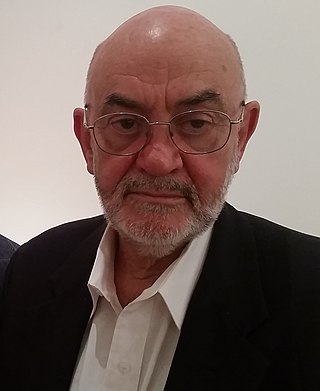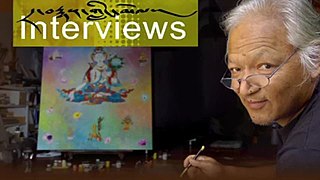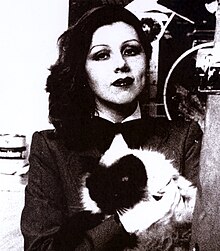
Rick Amor is an Australian artist and figurative painter. He was an Official War Artist for Australia.
Janet Dawson MBE is an Australian artist who was a pioneer of abstract painting in Australia in the 1960s, having been introduced to abstraction during studies in England while she lived in Europe 1957–1960 She was also an accomplished lithographic printer of her own works as well as those of other renowned Australian artists, a theatre-set and furniture designer. She studied in England and Italy on scholarships before returning to Australia in 1960. She won the Art Gallery of New South Wales Archibald Prize in 1973 with the portrait of her husband, Michael Boddy Reading. She has exhibited across Australia and overseas, and her work is held in major Australian and English collections. In 1977 she was awarded an MBE for services to art.
Janine Burke is an Australian author, art historian, biographer, novelist and photographer. She also curates exhibitions of historical and contemporary art. She is Honorary Senior Fellow, Faculty of Fine Arts and Music, University of Melbourne. She was born in Melbourne in 1952.
Vivienne Joyce Binns is an Australian artist known for her contribution to the Women's Art Movement in Australia, her engagement with feminism in her artwork, and her active advocacy within community arts. She works predominantly in painting.
Euan Heng, is an artist who is now living and working in Melbourne, Australia.
Julie Rrap is an Australian contemporary artist who was raised on the Gold Coast in Queensland She was born Julie Parr, and reversed her name to express her sense of opposition. Since the mid-1970's she has worked in photography, painting, sculpture, video and performance. Julie's work expresses her interest in images of the body, especially the female body.
Hany Armanious is an Australian artist who lives and works in Sydney. Armanious produces installations and sculptural forms, as well as paintings and drawings.
David Wadelton is an Australian artist who lives and works in Melbourne. He is best known for his cyber-pop paintings, almost photorealist in style.
Diane Mantzaris is an Australian artist known for her pioneering application of digital imaging to printmaking and for her unconventional approach to image making, which is often both personal and political in content. Mantzaris pioneered the use of computers as a printmaking and art-making tool in the early to mid-1980s, exhibiting widely, nationally and throughout Asia in touring exhibitions, to considerable acclaim. Her practice now crosses into several fields associated with the visual arts, printmaking, drawing, photography, sculpture, performance and public art. She is represented in most state and public collections throughout Australia and significant private collections throughout Asia and Europe.
Robert Rooney (1937–2017) was an artist and art critic from Melbourne, Australia, and a leading figure in Australian Conceptual art.

Bernard Ollis OAM is a British-Australian artist, painter and advocate for arts education. He lives and works in Sydney and Paris.

Karma Phuntsok is a Tibetan painter.
Robert Owen is an Australian artist and curator. He lives and works in Melbourne, Australia.
Kate Beynon is an Australian contemporary artist based in Melbourne. She was the 2016 winner of the Geelong Contemporary Art Prize for the painting, Graveyard scene/the beauty and sadness of bones.
Mikala Dwyer is an Australian artist born in 1959 in Sydney. She is a contemporary sculptor who was shortlisted with fellow artist Justene Williams to represent Australia at the 2019 Venice Biennale.
Stephen Wickham is an Australian photographer, painter and printmaker.
Lesley Dumbrell, born on 14 October 1941 in Melbourne, is an Australian artist known for her precise abstract geometric paintings, and was a pioneer of the Australian Women's Art Movement of the 1970s. She became known as 'one of the leading artists in Melbourne to adopt the international styles of colour field and hard-edged abstraction'.

The Field was the inaugural exhibition at the National Gallery of Victoria’s new premises on St Kilda Road, Melbourne. Launched by the director of London’s Tate gallery, Norman Reid, before an audience of 1,000 invitees, it was held between held 21 August and 28 September 1968. Hailed then, and regarded since as a landmark exhibition in Australian art history, it presented the first comprehensive display of colour field painting and abstract sculpture in the country in a radical presentation, between silver foil–covered walls and under geometric light fittings, of 74 works by 40 artists. All practised hard-edge, geometric, colour and flat abstraction, often in novel media including coloured or transparent plastic, fluorescent acrylic paints, steel and chrome. The art was appropriate to a launch of the new venue itself, designed by architect Roy Grounds, and emphatically rectilinear; cubes nested in a basalt rectangular box amongst the other buildings of the new Arts Centre, each based on a geometric solid. Echoing emerging international stylistic tendencies of the time, The Field sparked immediate controversy and launched the careers of a new generation of Australian artists.
Angela Cavalieri is an Australian printmaker.
Allan Mitelman is an Australian painter, printmaker and art teacher who arrived in Australia in 1953.





